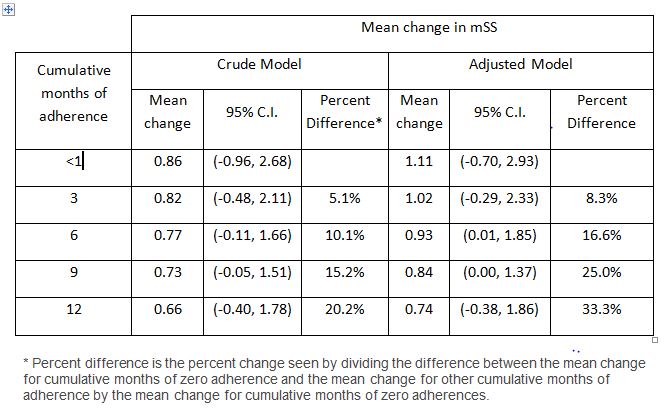Session Information
Date: Sunday, November 13, 2016
Title: Rheumatoid Arthritis – Small Molecules, Biologics and Gene Therapy - Poster I
Session Type: ACR Poster Session A
Session Time: 9:00AM-11:00AM
Background/Purpose: Tumor necrosis factor inhibitors (TNFi) are effective therapy for rheumatoid arthritis (RA) and have been shown to reduce progression of joint structural damage as measured by the modified Sharp Score (mSS). This observational study evaluated the relationship between cumulative adherence to TNFi therapy and progression of structural joint damage during the first year of TNFi therapy in US Veterans.
Methods: US Veterans with RA who were ≥18 years of age and initiated TNFi use after at least six months of enrollment in the Veterans Affairs (VA) health care system were eligible for this study. Subjects were identified through a search of national VA administrative data and copies of digital radiographs retrieved. Subjects were required to have bilateral baseline hand x-rays during the interval of between six months prior and one month after TNFi initiation and a set of follow-up bilateral hand x-rays during the interval between 10 and 18 months after TNFi initiation. Subjects with non-TNFi biologic disease modifying anti-rheumatic drugs (DMARDs) use prior to TNFi initiation or between baseline and follow-up x-rays were excluded. Cumulative TNFi exposure was calculated from VA administrative data and compared to change in mSS interpreted by a single evaluator blinded to sequence of x-rays and drug exposure history. A longitudinal marginal structural model using inverse probability of treatment weights was used to compare the impact of cumulative adherence on mean change in mSS. Baseline disease characteristics (e.g., smoking history, age, seropositive status, co-morbidities, and concurrent medication) and time-varying covariates (erythrocyte sedimentation rate, C-reactive protein, and prednisone) were assessed for clinical and statistical importance and included in the adjusted model in addition to the crude analysis.
Results: There were 114 patients from 36 sites who met enrollment criteria and had baseline and follow-up x-rays acceptable for evaluation. The population’s baseline demographic features were: mean±standard deviation age 59±11 years, 84% male, 68% positive for rheumatoid factor, and 58% positive for anti-cyclic citrullinated peptide antibody (aCCP). Baseline mSS was 20.5±14.2 (median 10, range 0-145). We observed decreases in the magnitude of mSS changes with increases in treatment adherence (i.e., cumulative TNFi exposure). In comparison to patients with no TNFi adherence, patients with the highest adherence had 20.2% and 33.3% less radiographic progression for the crude and adjusted model analysis, respectively.
Conclusion: The progression of radiographic changes as measured by mSS was very small during the one year of observation. While there was a trend for less progression in patients with increased adherence to TNFi therapy, these differences were not statistically significant.
To cite this abstract in AMA style:
Cannon GW, Erickson AR, Teng CC, Huynh T, Austin S, Stolshek BS, Mutebi A, Collier D, Wade SW, Sauer B. Impact of Adherence to Tumor Necrosis Factor Inhibitors on Radiographic Outcomes in US Veterans with Rheumatoid Arthritis [abstract]. Arthritis Rheumatol. 2016; 68 (suppl 10). https://acrabstracts.org/abstract/impact-of-adherence-to-tumor-necrosis-factor-inhibitors-on-radiographic-outcomes-in-us-veterans-with-rheumatoid-arthritis/. Accessed .« Back to 2016 ACR/ARHP Annual Meeting
ACR Meeting Abstracts - https://acrabstracts.org/abstract/impact-of-adherence-to-tumor-necrosis-factor-inhibitors-on-radiographic-outcomes-in-us-veterans-with-rheumatoid-arthritis/

